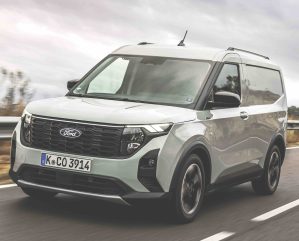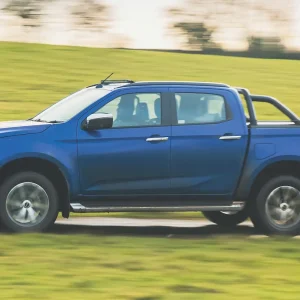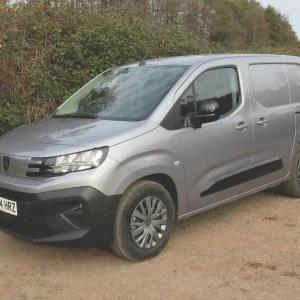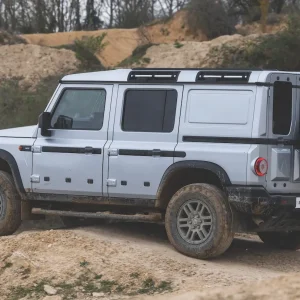
The new Ford Transit Courier is a very different beast to its predecessor, which had a lot in common with the now departed car-derived van, the Ford Fiesta Van.
The re-invented model is bigger, butcher and, visually at least, clearly gives a nod towards the American heritage of the blue oval brand, particularly with its higher, bold new grille.
With an eye on present and future markets Ford is making the Courier available in ICE (petrol and diesel) and battery-electric guises.
Petrol and diesel versions are available to order now and will come to market in the first quarter of 2024 while the BEV van will arrive in the UK early next year.
A prominent grille beneath a blue strip light is retained on the BEV as an aesthetic feature. Higher seating and more interior space gives the van an SUV-like feel. The Transit Courier will come in four trim levels: entry-level Leader, which Ford says will be the preference for large fleets, Trend, which will attract both fleets and SMEs, Limited, which Ford expects to appeal to both small businesses and owner-drivers and Active, which it says will be used by customers as both a work and lifestyle/ family vehicle.
A spokesperson predicted the petrol, manual Transit Courier in Limited trim would be the biggest seller in the UK.
Ford is producing the Transit Courier as both a panel van and double-cab-in van (DCiV).
The manufacturer is not initially bringing the DCiV to the UK but says demand will dictate whether it introduces this derivative later.
The panel van has a load volume of 2.9m3, which represents a 25% uplift on the previous Transit Courier. The standard payload across ICE models is circa 680kg, excluding the driver, but Ford says a higher payload version fitted with dual rate springs will be able to carry up to 845kg.
Ford claims the BEV Transit Courier will boast a payload of 700kg. Maximum towing capacities are put at 1,100kg for the diesel, 1,000kg for the petrol and 750kg for the BEV.
A load-through hatch in the bulkhead, which is up for grabs with all derivatives, enables items of up to 2,600mm, such as ladders, to be stowed inside the van’s load bay and LED lighting illuminates the cargo area.
Without the load-through hatch, the cargo length has been increased by 181mm to 1,802mm, while new rear suspension with angled shock absorbers has increased the load width between the wheel arches to 1,220mm, allowing the Courier to carry two Euro pallets. All panel vans come with 180º opening rear cargo doors and six floor tie-down points as standard. Despite bulking up, the new Courier has a kerb-to-kerb turning circle of 10.7m, which is only a tad more than the 10.5m of its predecessor. On the other hand, it doesn’t offer much improvement on the 10.8m of the larger short-wheelbase Stellantis compact vans, such as the Citroen Berlingo.
The Courier is integrated with Ford Pro’s platform of software and connected services, which are designed to optimise efficiency for customers from owner-drivers to large fleets. Aimed at small businesses, the Ford Pro smartphone app enables customers to remotely lock and unlock their van, check its location, track fuel spending, and receive health alerts for fluid levels, tyre pressures, oil life and brake condition to help prevent breakdowns. Customers with five or more vans can get access to Ford Pro Telematics, which uses live data to help maximise productivity and includes dashboards on vehicle location, health and servicing status. Ford Pro Software users can also access vehicle security alerts for collisions and break-ins. With Fleet Start Inhibit, fleet managers can remotely enable and disable Transit Couriers to help prevent theft or unauthorised use of vehicles outside of work hours.
The Courier’s cabin is tidy and clean with some useful storage features such as a narrow, central space for a laptop or paperwork, divided door bins with space for 1.5-littre water bottles and a cleverly designed dashboard mounting fin for a smartphone, which keeps the phone within the driver’s sightline. The centre point of the cab is an 8in touchscreen incorporating Ford’s SYNC 4 connectivity system.
The Transit Courier excels in its provision of ADAS (advanced driver assistance systems), which enabled it to gain an unprecedented Platinum safety rating from Euro NCAP and to win the What Van? Safety Award 2024 to boot.
Standard equipment includes: lane keeping assist, pre-collision assist, intelligent speed assist and rear parking sensors and optional equipment includes: intelligent adaptive cruise control with stop and go and lane centring when combined with the automatic transmission, blind spot information with cross traffic alert, intersection assist and reverse brake assist.
The diesel engine offered in the Transit Courier is a 1.5-litre 100hp Ecoblue with 250Nm of torque. This powertrain is paired with six-speed manual transmission only. The petrol engine is Ford’s 1.0-litre Ecoboost that comes with power outputs of either 100 or 125hp married to either six-speed manual or seven-speed dual-clutch automatic transmission. We drove the diesel and the 125hp petrol Courier with both the manual and auto gearboxes.
While the manual gearbox is impressively slick we found the diesel lacked mid-range grunt and accelerated sluggishly from speeds of about 30 to 40mph with a load of 250kg in the cargo bay. The petrol engines were far zippier and the pick of the bunch is the version with automatic transmission, which works in harmony with the responsive engine. Sharp steering offers plenty of feedback and ride quality is good throughout the range with in-cabin noise never becoming intrusive.
Getting connected
Ford gave us an insight into the third generation of its Transit Connect at the drive event for the Transit Courier.
The Connect is, of course, the Courier’s big brother, although the two models are closer in size than their predecessors as a result of “customers moving to larger compact vans”, according to Frank Butt, Ford Pro’s chief programme engineer.
The new Connect has been developed alongside the Volkswagen Caddy as part of the product alliance between Ford and VW. It will be available in panel van and Kombi formats and with diesel and PHEV (petrol/electric) powertrains. The diesel will arrive in the third quarter of 2024 with the PHEV coming in the fourth quarter and the Kombi joining the line-up the following year.
With the Connect and Courier overlapping in terms of load-carrying capacities, Ford claims the models will be differentiated by the Connect being positioned as a more premium choice. Offered in short- and long-wheelbase versions, standard features will include a 10in touchscreen in the cabin.
Ford claims the PHEV Connect will have an electric-only range of 110km (68 miles) and says the 1.5-litre Ecoboost engine will be offered with six-speed dual-clutch transmission. A 2.0-litre diesel engine will get power outputs of 102hp and 122hp.
A payload of 770kg will combine with load volumes of 3.1m3 in SWB and 3.7m3 in LWB guises.
The Kombi will feature a Flexi-seat that collapses and folds forward into a bulkhead to create an expanded load space.
Ford will offer the Connect in Trend and Limited grades with the addition of Active for the Kombi.
The manufacturer expect the SWB PHEV Connect to qualify for the £2,500 Plug-in-Van-Grant (PiVG) and the LWB version to qualify for the full £5,000 PiVG.
Ford Transit Courier 1.0-litre 125hp Ecoboost petrol Auto
Price (ex VAT) £21,150
Price range (ex VAT) £16,200 – £21,150
Insurance group tba
Warranty 3yrs/62,000mls
Service intervals 2yrs/25,000mls
Load length 1,802mm (2,667mm with load-through)
Load width (min/max)1,220mm/1,535mm
Load bay height 1,253mm
Gross payload 619kg
Load volume 2.9m3
Engine size/power 998cc/125hp
Combined fuel economy 38.2mpg
CO2 148g/km





